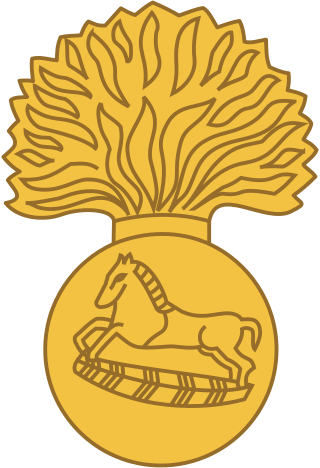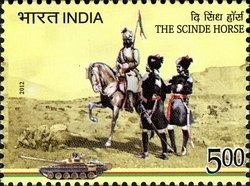
The Grenadiers is an infantry regiment of the Indian Army, formerly part of the Bombay Army and later the pre-independence British Indian Army, when the regiment was known as the 4th Bombay Grenadiers. It has distinguished itself during the two world wars and also since the Independence of India. The regiment has won many battle honours and gallantry awards, and is considered to be one of India's most decorated regiments with three Param Vir Chakra awardees in three different conflicts.

The Battle of Chawinda was a major engagement between Pakistan and India in the Second Kashmir War as part of the Sialkot campaign. It is well known as being one of the largest tank battles in history since the Battle of Kursk, which was fought between the Soviet Union and Nazi Germany in World War II.

45 Cavalry is an armoured regiment in the Armoured Corps of the Indian Army. The regiment distinguished itself in operations during the 1971 Indo-Pakistan War winning one Maha Vir Chakra.
The 15th Indian Division was an infantry division of the British Indian Army that saw active service in the First World War. It served in the Mesopotamian Campaign on the Euphrates Front throughout its existence. It did not serve in the Second World War, but was reformed at Dehradun in 1964 as part of the post-independence Indian Army.

The Scinde Horse is an armoured regiment in the Armoured Corps of the Indian Army. The regiment, known before independence as the 14th Prince of Wales's Own Scinde Horse was a regular cavalry regiment of the Bombay Army, and later the British Indian Army.

The 16th Light Cavalry is a regiment of the Armoured Corps, a primary combat arm of the Indian Army. Prior to India gaining independence from the British in 1947, it was a regular cavalry regiment of the British Indian Army. It was formed in 1776 and is the oldest armoured regiment raised in India. The 16th Light Cavalry saw service in a number of conflicts ranging from the Second Anglo-Mysore War in 1781 to World War II. It has a number of battle honours including "Punjab 1965" earned during the Indo-Pakistani War of 1965.
67th Armoured Regiment is an armoured regiment which is part of the Armoured Corps of the Indian Army.

62 Cavalry was a pioneering component of the armoured corps of India. Its raising as the first armoured regiment of an independent nation merged the flair of Risala with the vision of an emergent army. The regiment was exemplified in an array of regimental insignia and colours that were a break from the usual pennants and lances, and reflected the efforts put into their design and conception.
90 Armoured Regiment is an armoured regiment of the Indian Army.
63rd Cavalry is an armoured regiment of the Indian Army.
20th Lancers is an armoured regiment in the Armoured Corps of the Indian Army. The regiment distinguished itself in operations with its defence of Chhamb in Jammu and Kashmir during the 1965 Indo-Pakistan War and won one Maha Vir Chakra. It has provided one Chief of Army Staff and two Army Commanders.
The 64th Cavalry is an armoured regiment of the Armoured Corps of the Indian Army.
65th Armoured Regiment, is an armoured regiment which is part of the Armoured Corps of the Indian Army.
66th Armoured Regiment is an armoured regiment which is part of the Armoured Corps of the Indian Army.

Brigadier Narinder Singh Sandhu MVC was an Indian Army officer who was awarded the Maha Vir Chakra (MVC), the second-highest Indian military decoration, for gallantry, leadership and devotion to duty during the Indo-Pakistan War of 1971. Sandhu was commissioned into the Indian Army Armoured Corps in 1953, and participated in the Battle of Asal Uttar during the Indo-Pakistani War of 1965, and was mentioned in dispatches. He transferred to the Dogra Regiment in 1970, and it was for his performance as commanding officer of the 10th Battalion, Dogra Regiment during an assault on a fortified Pakistan Army position that he was awarded the MVC. He retired as a brigadier and was active in veterans' and gallantry award recipients' matters until his death of colorectal cancer in 2018.
36 Medium Regiment is an artillery regiment which is part of the Regiment of Artillery of the Indian Army.

75 Armoured Regiment is an armoured regiment of the Indian Army.
69 Armoured Regiment is an armoured regiment of the Indian Army.
72 Armoured Regiment is an armoured regiment of the Indian Army. The regiment was raise at Ahmednagar, Maharashtra on 1st July 1971.
101 Field Regiment is part of the Regiment of Artillery of the Indian Army.








